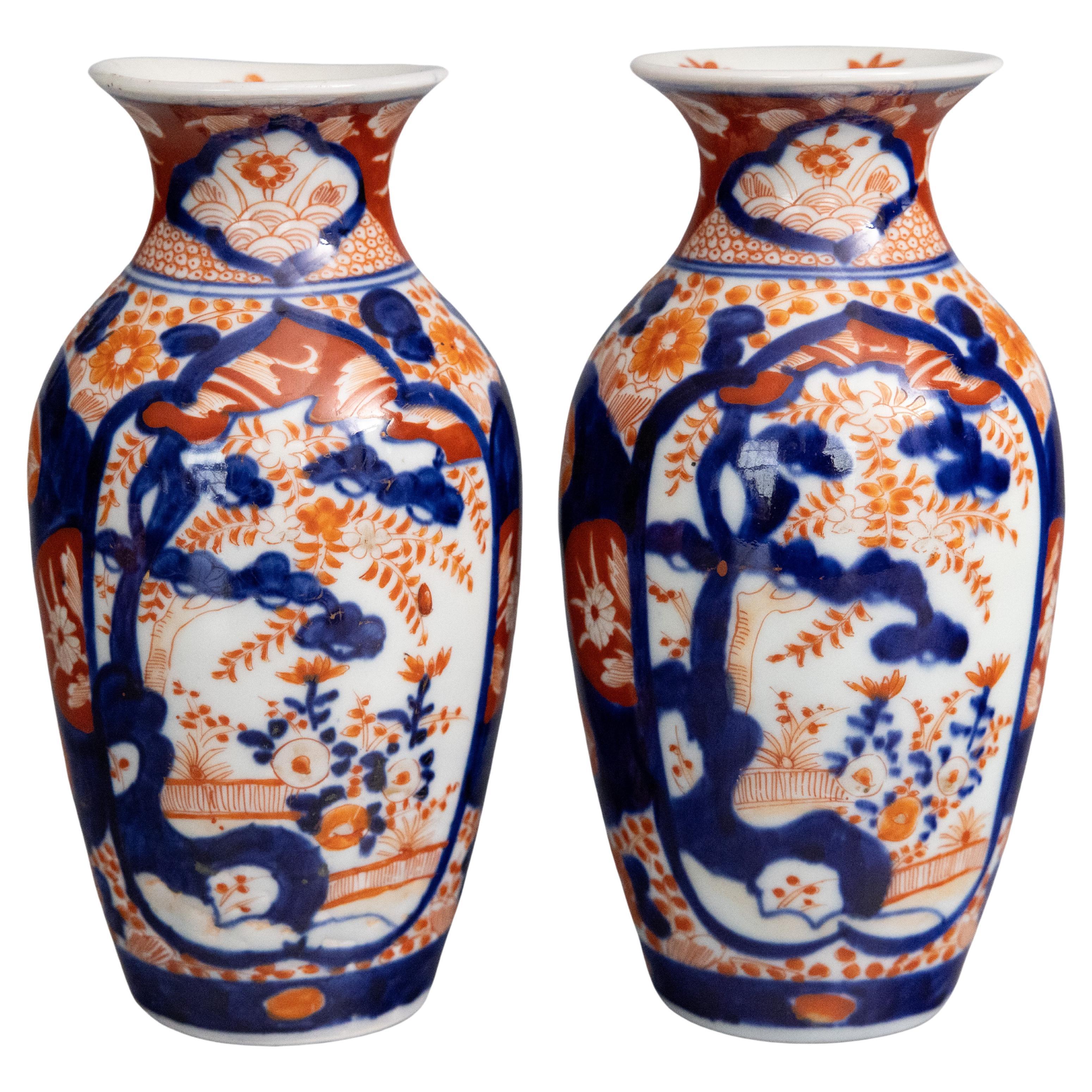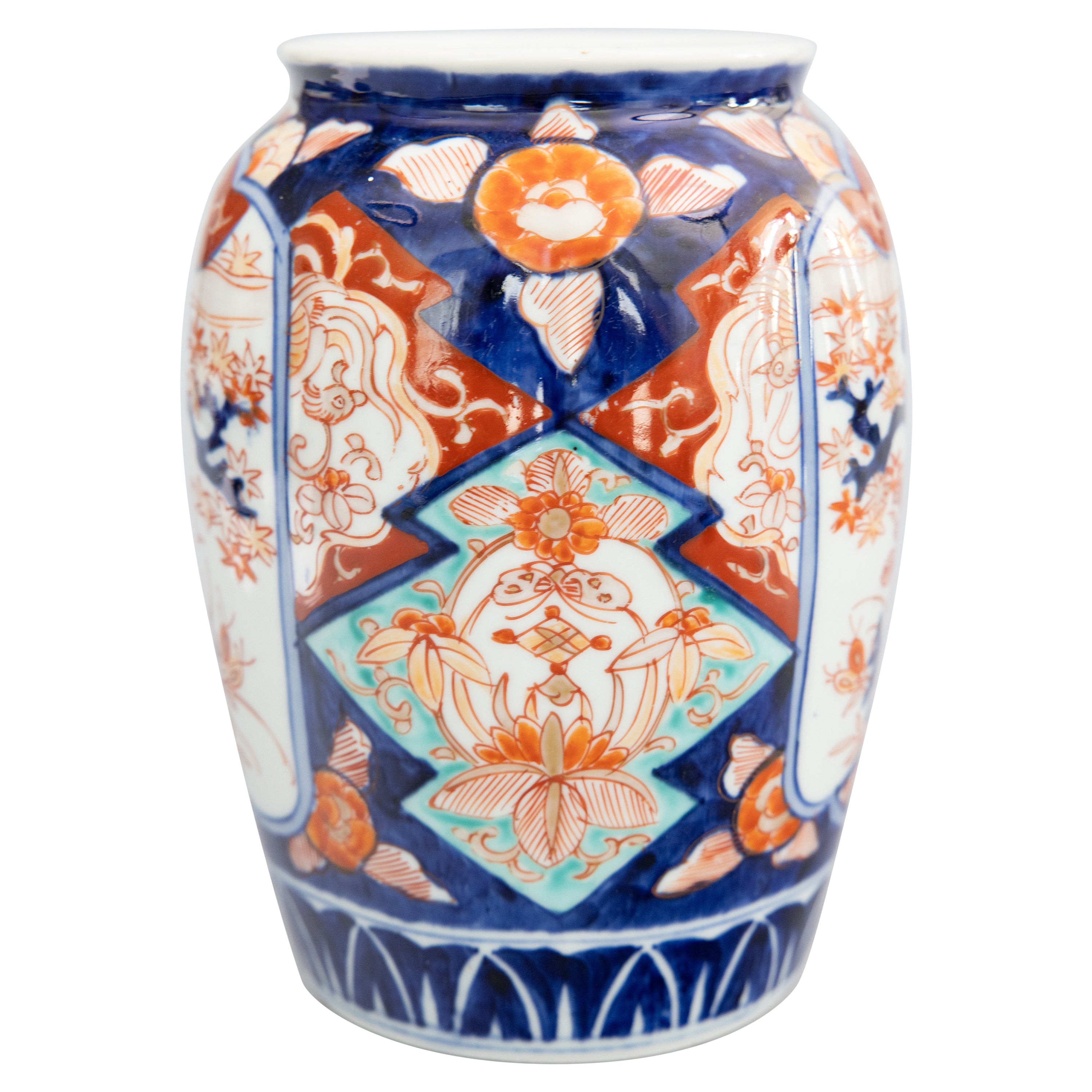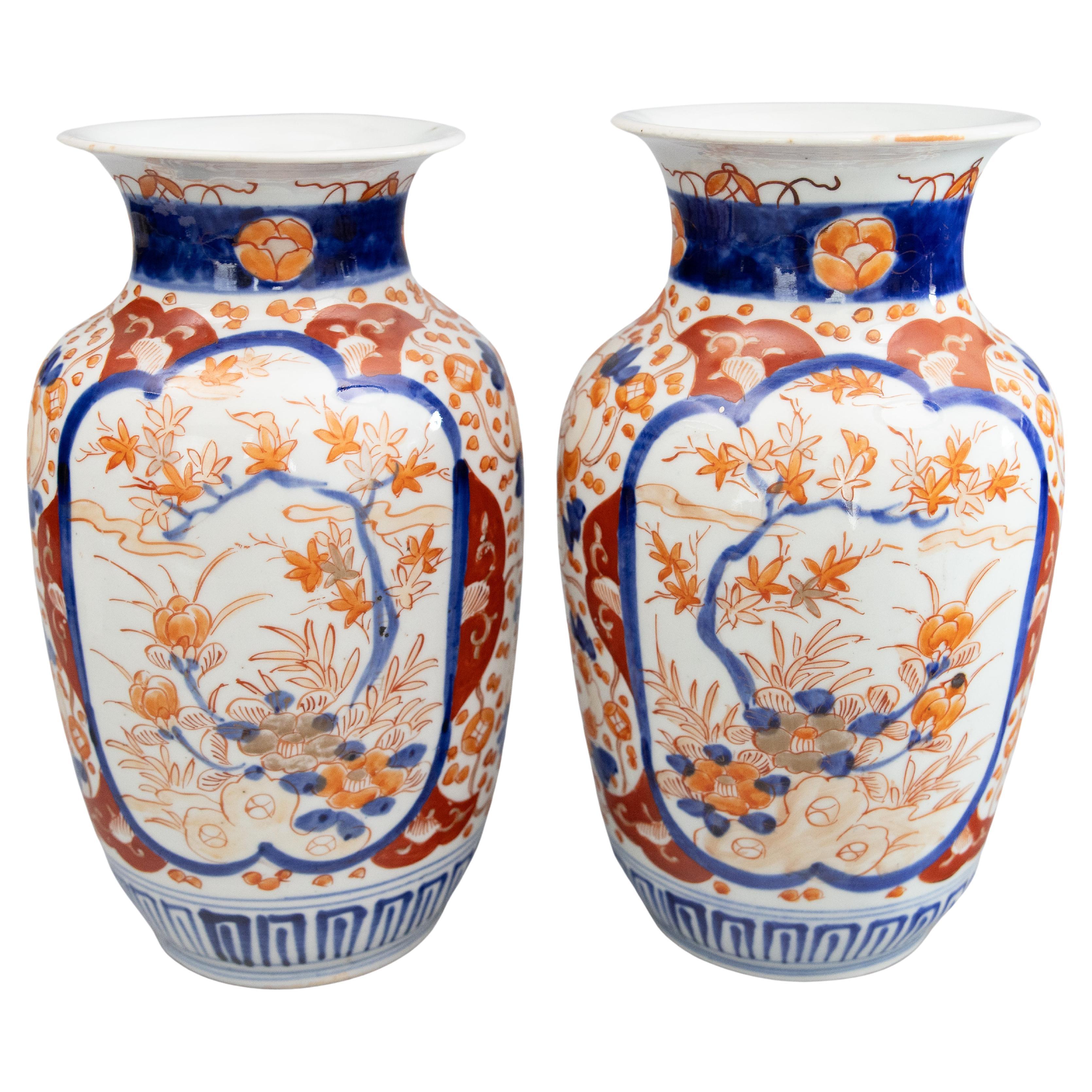Items Similar to Antique 19th Century Japanese Imari Porcelain Vase/Brush Pot
Want more images or videos?
Request additional images or videos from the seller
1 of 8
Antique 19th Century Japanese Imari Porcelain Vase/Brush Pot
About the Item
19th-Century Japanese Imari porcelain vase/brush pot. This fine vase have a lovely shape and hand painted floral designs in the traditional Imari colors.
- Creator:Imari Porcelain (Artist)
- Dimensions:Height: 5 in (12.7 cm)Width: 4 in (10.16 cm)Depth: 4 in (10.16 cm)
- Style:Japonisme (Of the Period)
- Materials and Techniques:Porcelain,Fired
- Place of Origin:
- Period:
- Date of Manufacture:19th Century
- Condition:Wear consistent with age and use.
- Seller Location:Pearland, TX
- Reference Number:
About the Seller
5.0
Platinum Seller
These expertly vetted sellers are 1stDibs' most experienced sellers and are rated highest by our customers.
Established in 2017
1stDibs seller since 2021
285 sales on 1stDibs
Typical response time: <1 hour
- ShippingRetrieving quote...Ships From: Pearland, TX
- Return PolicyA return for this item may be initiated within 3 days of delivery.
More From This SellerView All
- Antique 19th Century Japanese Imari Porcelain VaseBy Imari PorcelainLocated in Pearland, TX19th-Century Japanese Imari porcelain vase. This fine vase have a lovely shape and hand painted floral designs in the traditional Imari colors.Category
Antique 19th Century Japanese Japonisme Vases
MaterialsPorcelain
- Antique 19th Century Japanese Imari Porcelain Vases - a PairBy Imari PorcelainLocated in Pearland, TXA handsome pair of 19th-Century Japanese Imari porcelain vases. These fine vases have a lovely shape and hand painted floral designs in the traditional Imari colors.Category
Antique 19th Century Japanese Japonisme Vases
MaterialsPorcelain
- Antique 19th Century Japanese Imari Porcelain VaseBy Imari PorcelainLocated in Pearland, TXA gorgeous antique 19th-Century Japanese Imari vase made in the Meiji period, circa 1870. This fine vase has a lovely lobed shape and hand painted floral design in the traditional Im...Category
Antique 19th Century Japanese Meiji Vases
MaterialsPorcelain
- Antique 19th Century Meiji Period Japanese Imari Porcelain VaseBy Imari PorcelainLocated in Pearland, TXA gorgeous antique 19th-Century Japanese Imari vase made in the Meiji period, circa 1870. This fine vase has a lovely fluted shape, scalloped rim, and hand painted floral design in t...Category
Antique 19th Century Japanese Meiji Vases
MaterialsPorcelain
- Pair of 19th Century Japanese Imari Porcelain VasesBy Imari PorcelainLocated in Pearland, TXA gorgeous pair of 19th-Century Japanese Imari porcelain vases. These fine vases have a lovely shape and hand painted floral designs in the traditional Imari colors. They are in beau...Category
Antique Late 19th Century Japanese Vases
MaterialsPorcelain
- Antique 19th Century Japanese Imari Porcelain VaseLocated in Pearland, TXA gorgeous antique 19th-Century Japanese Imari porcelain vase. This fine vase is a nice large size and has a lovely shape and hand painted floral design in the traditional Imari...Category
Antique 19th Century Japanese Vases
MaterialsPorcelain
You May Also Like
- Pair of Large Imari Porcelain Vases, Japan, Late 19th CenturyBy Imari PorcelainLocated in PARIS, FRA very fine pair of Imari porcelain vases, of tapering form with flared top. Decorated with polychrome birds and flowers on white background. The body is painted with shaped panels o...Category
Antique Late 19th Century Japanese Vases
MaterialsPorcelain
- Pair 19th Century Japanese Imari Porcelain & Gilt-Bronze Torchere CandelabraBy Imari PorcelainLocated in Los Angeles, CAA fine Pair of 19th century Japanese Imari Porcelain and French Gilt-Bronze Mounted Thirteen-Light Celadon Torchere Candelabra. The bottle-shaped Japonisme vases with a Royal red background, decorated with parcel-gilt and black soaring eagles in the hunt within a forestall scene. Each Vase fitted and surmounted with a French 19th century Louis XV Style 13-Light scrolled candelabrum and all raised on a circular pierced gilt-bronze plinth. circa: 1880. Imari Porcelain (????) is the name for Japanese porcelain wares made in the town of Arita, in the former Hizen Province, northwestern Kyushu. They were exported to Europe extensively from the port of Imari, Saga, between the second half of the 17th century and the first half of the 18th century. The Japanese as well as Europeans called them Imari. In Japanese, these porcelains are also known as Arita-yaki (???). Imari or Arita porcelain has been continously produced up through the present day. Characteristics Though there are many types of Imari, Westerners' conception of Imari in the popular sense is associated only with a type of Imari produced and exported in large quantity in mid-17th century. This type is called Kinrande. Kinrande Imari is colored porcelain with cobalt blue underglaze and red and gold overglaze. The color combination was not seen in China at that time. Traditional Ming dynasty color porcelain used dominantly red and green, probably due to scarcity of gold in China, whereas gold was abundant in Japan in those days. The subject matter of Imari is diverse, ranging from foliage and flowers to people, scenery and abstractions. Some Imari design structures such as kraak style were adopted from China, but most designs were uniquely Japanese owing to the rich Japanese tradition of paintings and costume design. The porcelain has a gritty texture on the bases, where it is not covered by glaze. There is also blue and white Imari. Kakiemon style Imari is another type of Imari, but it tends to be categorized separately in Europe. History "Imari" was simply the trans-shipment port for Arita wares. It was the kilns at Arita which formed the heart of the Japanese porcelain industry. Arita's kilns were set up in the 17th century, when kaolin was discovered in 1616 by the immigrant Korean potter, Yi Sam-pyeong (1579–1655). (He may also be known by the name, "Kanage Sambei".) Yi Sam-Pyeong, along with his extended family of 180 persons, left Korea on the offer of a privileged position in Japan. This decision was made after the occurrence of certain Japanese invasions of Korea. After Yi Sam-Pyeong's discovery, his kilns began to produce revised Korean-style blue and white porcelains, known as "Shoki-Imari". In the mid-17th century there were also a lot of Chinese refugees in Northern Kyushu due to the turmoil on Chinese continent, and it is said one of them brought coloring technique to Arita. Thus Shoki-Imari developed into Ko-KutaniImari. Ko-Kutani was produced around 1650 for both export and domestic market. Blue and white porcelain continued to be produced and they are called Ai-Kutani. Ko-Kutani Imari for the export market usually adopted Chinese design structure such as kraak style, whereas Ai-Kutani for the domestic market were highly unique in design and are accordingly valued very much among collectors. Ko-Kutani style evolved into Kakiemon style Imari, which was produced for about 50 years around 1700. Imari achieved its technical and aesthetic peak in Kakiemon style, and it dominated European market. Blue and white Kakiemon is called Ai-Kakiemon. Kakiemon style transformed into Kinrande in the 18th century. Kinrande used blue underglaze and red and gold overglaze, and later some other colors. Imari began to be exported to Europe because the Chinese kilns at Ching-te-Chen were damaged in the political chaos and the new Qing dynasty government stopped trade in 1656–1684. Exports to Europe were made through the Dutch East India Company, but the designation "Imari Porcelain" in Europe connotes Arita wares of mostly Kinrande Imari. Export of Imari to Europe stopped in mid-18th century when China began export to Europe again, since Imari was not able to compete against China due to high labor cost. By that time, however, both Imari and Kakiemon style were already so popular among Europeans, Chinese export porcelain copied both Imari and Kakiemon style, which is called Chinese Imari. At the same time, European kilns, such as Meisen also tried to copy Imari and Kakiemon. Export of Imari surged again in late 19th century (Meiji era) when Japonism flourished in Europe. Thus in western world today, two kinds of Imari can...Category
Antique 19th Century Japanese Japonisme Floor Lamps
MaterialsOrmolu, Bronze
- Pair of 19th Century Japanese Imari Porcelain VasesLocated in New York, NYPair of 19th century Japanese Imari Porcelain vases with slender necks depicting floral and bird motifs in shade of red and cobalt.Category
Antique 19th Century Asian Japonisme Vases
MaterialsPorcelain
- Large 19th Century Japanese Imari Ware Porcelain VaseLocated in Bradenton, FLA large scale and very good quality late 19th century Japanese Imari vase with exotic birds, trees and flowers. Wonderful coloring in vibrant hues of blue, red and rust.Category
Antique 19th Century Japanese Japonisme Ceramics
MaterialsPorcelain
- Imari Japanese Porcelain Vase, 19th CenturyLocated in Savannah, GAImari Japanese Porcelain Vase, 19th CenturyCategory
Antique 19th Century Japanese Vases
MaterialsPorcelain
- Late 19th Century Porcelain Chinese Imari Famille Rose VaseBy Imari PorcelainLocated in Banner Elk, NCLarge late 19th century Chinese Export Porcelain Imari and Famille Rose hand painted vase. Extremely rare coloration.Category
Antique Late 19th Century Japanese Vases
MaterialsPorcelain
Recently Viewed
View AllMore Ways To Browse
Traditional Japanese Vase
Fine Porcelain Japanese Vase
Antique Japanese Vessels
Japanese Pots And Vessels
Picasso Josephine
Porous Clay Pots
Mdina Glass Fish Vase
Diamond Cut Crystal Footed Vase
Tiffany Favrile Floriform Tall
Savoy 3030
Molded Art
Weller Ware
Olive Ceramic
Swedish White Ceramic
Art Deco Stoneware
Vintage Scandinavian Stoneware
Italian Glass Heavy Vase
Ceramic Centerpiece Vessel





